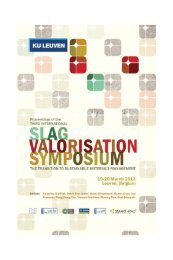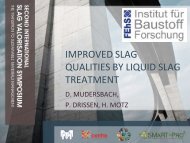International Slag Valorisation SymposiumLeuven6-7/4/2009 - Third ...
International Slag Valorisation SymposiumLeuven6-7/4/2009 - Third ...
International Slag Valorisation SymposiumLeuven6-7/4/2009 - Third ...
Create successful ePaper yourself
Turn your PDF publications into a flip-book with our unique Google optimized e-Paper software.
weathering solid wastes, it was necessary to take this process into account when<br />
assessing long-term treatment options. The effect of carbonation on leaching of heavy<br />
metals from incinerator residues became a focal point of the group, both with respect to<br />
solid waste as such and solid waste incorporated in cement matrices. When it became<br />
clear that in some conditions, carbonation can have a positive effect on heavy metal<br />
leaching (i.e. decrease leaching), accelerated carbonation was investigated as a<br />
treatment method to enhance environmental properties.<br />
Over 20 years of investigation has led to various papers, conference communications<br />
and PhD dissertations in the field of carbonation. A list of the most important ones is<br />
provided in the references. 1-26) In the future the groups will collaborate to investigate<br />
mineral carbonation systematically, with a focus on processing conditions, product<br />
properties (structural, mineralogical and environmental) and in-situ analysis.<br />
This conference paper reviews the most important findings at the K.U.Leuven relative<br />
to mineral carbonation, by focusing on the three domains of expertise: processing<br />
conditions, product properties and in-situ analysis. At the end, future directions of the<br />
research are described.<br />
Contributions by K.U.Leuven<br />
The carbonation reaction in mortars and other alkaline materials is a rather complex<br />
mechanism composed of diffusion of the CO2 through the pore structure and its<br />
dissolution in the capillary pore water where its reaction with calcium hydroxide occurs<br />
with the precipitation of calcium carbonate crystals. For a better understanding of this<br />
reaction mechanism in mortars, research has been carried out to clarify the diffusion<br />
term and the reaction term. Based on gas diffusion in a porous medium, Van Balen 1)<br />
provided the very first one-dimensional modelling of the lime mortar carbonation,<br />
taking into account the combined CO2 diffusion with water (vapour) transfer. This<br />
research has identified the interrelationship between CO2 diffusion and water content in<br />
the mortar, considering the water produced from the carbonation reaction itself.<br />
Numerical models show that the carbonation reaction starts quickly on the outer surface<br />
of the lime mortar and the CO2 diffusion controlled phase starts when the mortar has<br />
dried enough. The quick start and fast blockage is due to the limited diffusion resistance<br />
at start and due to the blockage of diffusion resulting from the water produced by<br />
carbonation. 1,2)<br />
The carbonation reaction model in lime mortars was improved with further research<br />
based on experimental studies on the diffusion term and the reaction term. The effective<br />
diffusivity of CO 2 in carbonated lime mortars was studied using a Wicke and<br />
Kallenbach type of set-up composed of a diffusion cell and a CO 2-gas analyzer. 3) The<br />
CO2 diffusion coefficient was determined in relation to different water contents.<br />
1 st <strong>International</strong> <strong>Slag</strong> <strong>Valorisation</strong> Symposium│Leuven│6-7/4/<strong>2009</strong><br />
28







